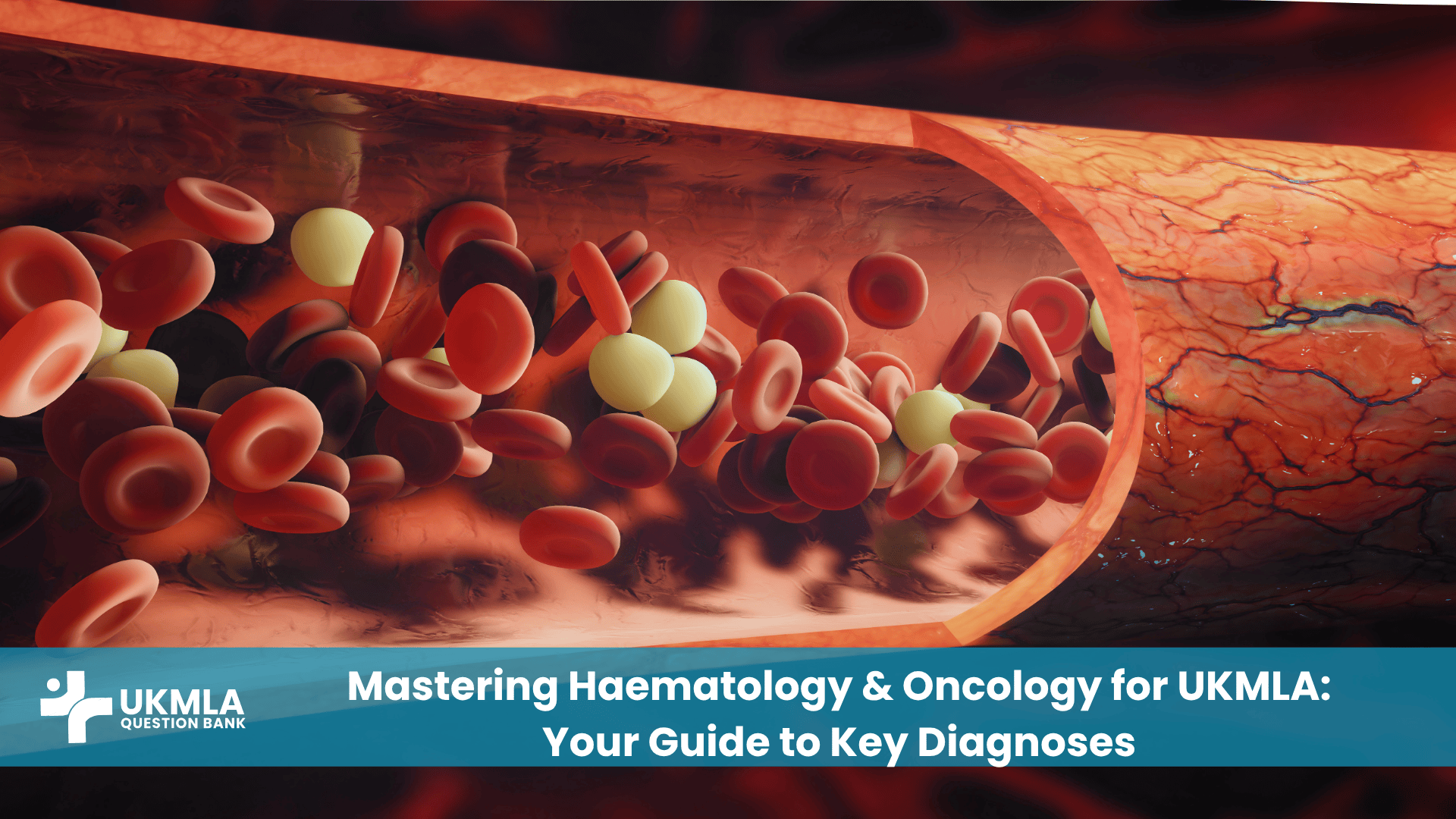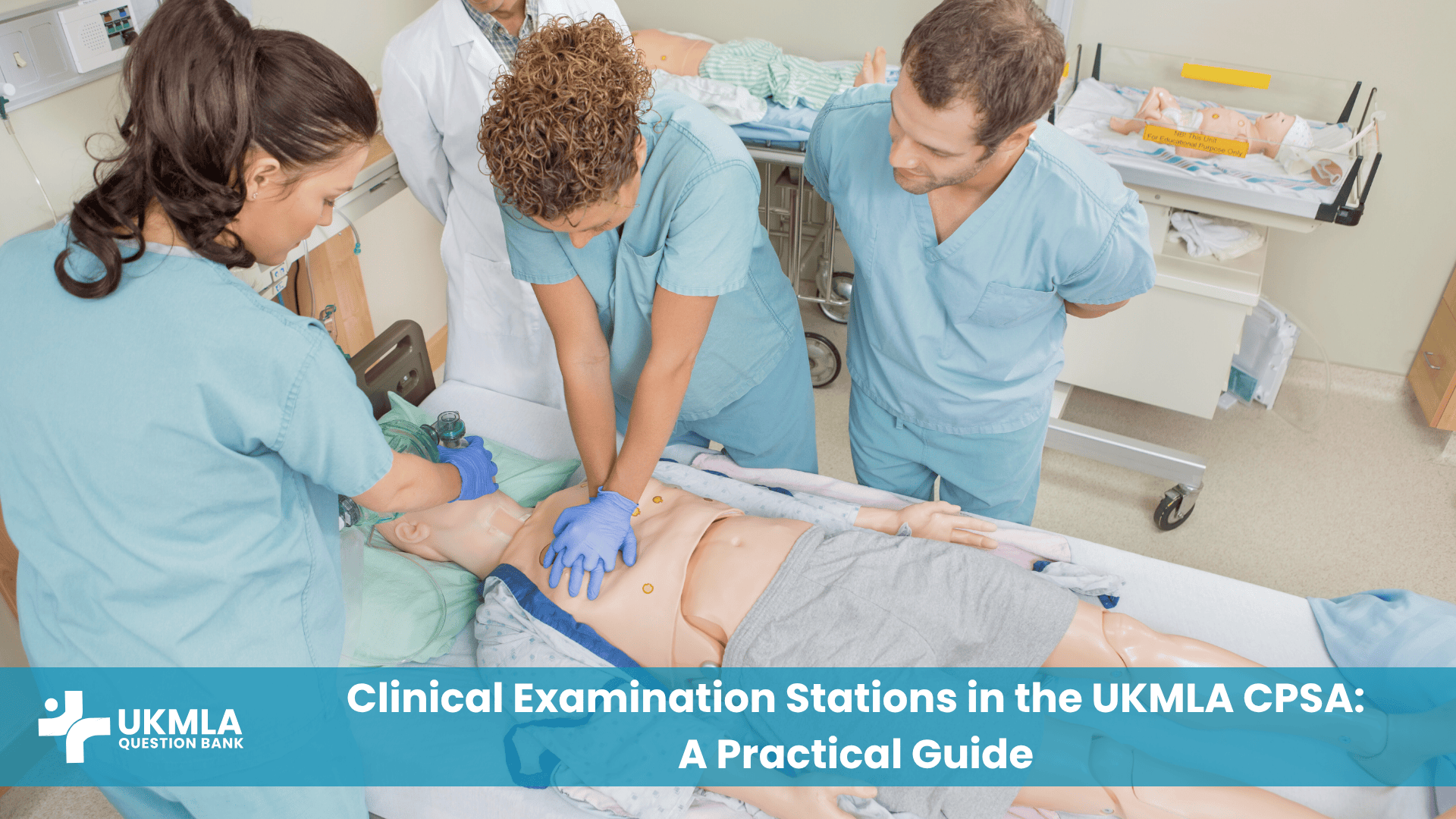The key to mastering Haematology & Oncology for UKMLA lies in pattern recognition. You’re faced with a full blood count report: the white cell count is alarmingly high, platelets are dangerously low, and the film report mentions “blasts.” For many candidates, this triggers a wave of anxiety. Is this acute leukaemia? Is it a leukaemoid reaction? This ability to interpret complex results and formulate a safe initial management plan is precisely what the UKMLA assesses.
This area of medicine can seem intimidating, filled with complex classification systems and powerful chemotherapies. However, for the UKMLA, you are not expected to be a specialist. Instead, you are expected to be a safe, competent Foundation Year doctor who can identify key patterns, recognise life-threatening emergencies, and understand the principles behind the initial diagnostic workup.
This guide is designed to be your framework for success. We will break down the essential, high-yield diagnoses you must know, from the common anaemias to the critical oncological emergencies. We will focus on the diagnostic clues and management principles that are most frequently tested, grounding everything in the UK-based guidelines from NICE and the British Society for Haematology (BSH).
Key Takeaways
- Systematic Approach is Key: Don’t get lost in details. Learn to systematically interpret a full blood count and blood film report to generate a logical differential diagnosis.
- Differentiate the Key Malignancies: Have a clear framework for distinguishing between the acute and chronic leukaemias (ALL, AML, CLL, CML), lymphomas, and myeloproliferative neoplasms based on age, presentation, and key cell types.
- Master the Anaemias: You must be able to differentiate microcytic, normocytic, and macrocytic anaemias, as this is one of the most common topics in haematology.
- Recognise Emergencies: Be able to immediately identify and act upon life-threatening oncological emergencies, specifically Neutropenic Sepsis and Metastatic Spinal Cord Compression.
- Focus on Principles, Not Protocols: The UKMLA tests your understanding of why certain treatments are used (e.g., the principles of anticoagulation), not just memorised specialist protocols.
Core Concepts for Mastering Haematology & Oncology for UKMLA
The Anaemias: More Than Just a Low Haemoglobin
Anaemia is guaranteed to appear on your exam. The key to answering these questions correctly is to use the Mean Corpuscular Volume (MCV) to classify the anaemia first, which then narrows your differential diagnosis significantly. A patient with microcytic anaemia will have a different set of underlying causes than a patient with macrocytic anaemia, and the subsequent investigations will differ accordingly.
A Word from a Haematology Consultant: “The full blood count is the single most important investigation in haematology. Before you look at anything else, find the haemoglobin and the MCV. Those two values alone will tell you which path to go down next. A systematic approach is everything.”
Investigation Principles:
- For microcytic anaemia: The key is to differentiate iron deficiency from thalassaemia. A ferritin level is the most important test; it is low in iron deficiency but normal or high in thalassaemia. Haemoglobin electrophoresis is used to diagnose thalassaemia.
- For normocytic anaemia: The context is everything. In a patient with rheumatoid arthritis or long-standing kidney disease, anaemia of chronic disease is likely. In a patient with acute bleeding, the cause is obvious. Blood film analysis is crucial to look for features of haemolysis.
- For macrocytic anaemia: A B12 and folate level is the essential first step. If B12 is low, further tests for pernicious anaemia (e.g., intrinsic factor antibodies) are warranted. A thorough alcohol and drug history is also vital.
Table 1: Differentiating the Common Causes of Anaemia
| Anaemia Type | MCV | Key Cause(s) | Blood Film & Key Findings |
|---|---|---|---|
| Microcytic | < 80 fL | Iron Deficiency (chronic blood loss, poor diet), Thalassaemia | Pencil cells, target cells. Low ferritin is key for iron deficiency. |
| Normocytic | 80-100 fL | Anaemia of Chronic Disease, Acute blood loss, Renal failure (low EPO) | Normal-looking red cells. Raised inflammatory markers (CRP, ESR). |
| Macrocytic | > 100 fL | Megaloblastic: B12/Folate deficiency. Non-megaloblastic: Alcohol excess, Liver disease, Hypothyroidism. |
Megaloblastic: Hypersegmented neutrophils, oval macrocytes. |
2. Leukaemias & Lymphomas: Recognising the Patterns
You are not expected to know detailed chemotherapy regimens. However, you must be able to recognise the classic presentation of the main types of haematological malignancy to ensure an urgent referral to a specialist. The key is differentiating acute from chronic, and lymphoid from myeloid.
- Acute Leukaemias (ALL/AML): These present aggressively with the signs and symptoms of bone marrow failure. Patients are unwell. The blood film shows blast cells, which are immature and non-functional.
- Chronic Leukaemias (CLL/CML): These have an insidious onset. Patients are often well and the high white cell count is found incidentally on a routine FBC. The cells are mature but dysfunctional.
- Lymphomas (Hodgkin/Non-Hodgkin): These are cancers of the lymphatic system, so they typically present with solid tumours in lymph nodes (lymphadenopathy). Systemic “B symptoms” (fevers, night sweats, weight loss) are common.
Table 2: Differentiating the “Big Four” Haematological Malignancies
| Condition | Typical Age | Key Cell Type / Feature | Classic Presentation |
|---|---|---|---|
| Acute Lymphoblastic Leukaemia (ALL) | Children | Lymphoblasts | Bone marrow failure: anaemia (fatigue), neutropenia (infections), thrombocytopenia (bleeding/bruising). |
| Acute Myeloid Leukaemia (AML) | Older Adults | Myeloblasts, Auer rods | Bone marrow failure (as above). More common in adults. |
| Chronic Lymphocytic Leukaemia (CLL) | Elderly (>60) | Mature B-lymphocytes (smear/smudge cells) | Often asymptomatic, found on routine FBC (very high lymphocyte count). Can have lymphadenopathy. |
| Chronic Myeloid Leukaemia (CML) | Middle-aged | Mature granulocytes (neutrophils, basophils) | Insidious onset. Massive splenomegaly. Associated with Philadelphia chromosome (BCR-ABL fusion gene). |
3. Myeloproliferative Neoplasms (MPNs)
This group of disorders is characterized by the overproduction of one or more types of mature blood cells. They are a key part of mastering Haematology & Oncology for UKMLA.
- Polycythaemia Vera (PV): An overproduction of red blood cells, leading to a high haematocrit (Hct) and haemoglobin (Hb). This causes “hyperviscosity,” where the blood is thick. Patients present with headaches, dizziness, and a classic pruritus (itching) after a hot bath. They may have a ruddy complexion. The key mutation is JAK2 V617F.
- Essential Thrombocythaemia (ET): An overproduction of platelets. This paradoxically increases the risk of both thrombosis (clotting) and bleeding. It is also associated with the JAK2 mutation.
- Myelofibrosis: The bone marrow becomes progressively replaced by fibrous scar tissue. This leads to bone marrow failure and “extramedullary haematopoiesis,” where other organs (like the spleen and liver) try to take over blood cell production, leading to massive hepatosplenomegaly. The blood film classically shows “tear-drop” red cells.
4. Disorders of Haemostasis: Bleeding and Clotting
Haemostasis is a balancing act. The UKMLA will test your understanding of what happens when this balance is tipped towards either bleeding or clotting.
- Bleeding Disorders: You should understand the difference between primary haemostasis (platelet plug formation) and secondary haemostasis (clotting cascade). A patient with a platelet issue (e.g., Immune Thrombocytopenic Purpura – ITP) will present with mucosal bleeding (gums, nosebleeds) and petechiae. A patient with a clotting factor issue (e.g., Haemophilia, von Willebrand Disease) will have deep muscle/joint bleeds (haemarthrosis) and large bruises. A coagulation screen (PT, APTT) is essential here.
- Clotting Disorders (Thrombophilia): Questions often focus on when to suspect an underlying thrombophilia (e.g., unprovoked DVT/PE in a young person, recurrent miscarriages, or clots in unusual sites). You should be aware of key inherited conditions like Factor V Leiden and Antiphospholipid Syndrome. Crucially, you must understand the principles of anticoagulation: the rapid action of heparin/LMWH for acute treatment vs. the slower onset of warfarin (monitored by INR) or the convenience of DOACs for long-term prevention.
5. Critical Oncological Emergencies
Recognising these two emergencies is a vital part of safe practice and one of the most important Emergency Medicine Essentials for UKMLA. Your ability to act quickly can be life-saving.
Key Point: Neutropenic Sepsis is a life-threatening emergency. The standard UK practice defines it as a patient on recent chemotherapy presenting with a fever (temperature >38°C or other signs of sepsis) and a neutrophil count <1.0 x 10⁹/L. They must be admitted immediately for urgent broad-spectrum IV antibiotics (e.g., Piperacillin/Tazobactam – ‘Tazocin’), as per local trust guidelines, ideally within one hour. Do not delay treatment waiting for cultures.
Key Point: Metastatic Spinal Cord Compression (MSCC) must be on your differential for any patient with a known malignancy (especially prostate, breast, or lung) who presents with new, progressive back pain (especially if worse on lying down/coughing) or any neurological symptoms in their lower limbs (weakness, sensory changes, bladder/bowel dysfunction). Immediate management involves giving high-dose oral or IV dexamethasone and arranging an urgent MRI of the whole spine.
Frequently Asked Questions (FAQ) Your UKMLA Haematology & Oncology Questions Answered
B symptoms are a triad of systemic symptoms associated with lymphoma: fevers (unexplained, >38°C), drenching night sweats, and unintentional weight loss (>10% of body weight over 6 months). Their presence often indicates a more aggressive disease.
A left shift refers to the presence of immature neutrophil precursors (like metamyelocytes and myelocytes) in the peripheral blood. It typically indicates the bone marrow is responding to severe infection or inflammation, but can also be a feature of CML.
Warfarin is monitored using the International Normalised Ratio (INR), which is a standardised measure of the prothrombin time (PT). The target INR depends on the indication for anticoagulation but is typically 2.0-3.0 for conditions like AF or DVT/PE.
It is an oncological emergency that occurs when a large number of cancer cells are killed rapidly by chemotherapy, releasing their intracellular contents into the bloodstream. This leads to a classic metabolic disturbance: hyperkalaemia, hyperphosphataemia, hypocalcaemia, and hyperuricaemia, which can cause acute kidney injury and arrhythmias.
The definitive difference is histological: Hodgkin lymphoma is characterized by the presence of large, distinctive Reed-Sternberg cells. Clinically, Hodgkin lymphoma often presents in younger adults and spreads contiguously (in a predictable pattern) through lymph nodes.
Von Willebrand Disease is the most common inherited bleeding disorder, affecting platelet function and the Factor VIII carrier protein. It typically presents with milder mucosal bleeding rather than the deep joint bleeds of haemophilia.
Ferritin is an acute phase reactant, meaning its levels can be normal or high in the presence of inflammation or infection, even if the patient is also iron deficient. Therefore, while a normal ferritin doesn’t rule out iron deficiency in a sick patient, a low ferritin is diagnostic.
It is a specific chromosomal abnormality resulting from a translocation between chromosome 9 and 22 [t(9;22)]. This creates the BCR-ABL fusion gene, which is the pathognomonic feature of Chronic Myeloid Leukaemia (CML) and a target for specific therapies.
Tear-drop shaped red cells (dacryocytes) are classically associated with myelofibrosis. They are thought to be formed when red blood cells are damaged as they are forced out of the fibrotic bone marrow.
In simple terms, AML is an acute, aggressive cancer treated with intensive induction chemotherapy with the aim of a cure. CML is a chronic condition managed long-term with targeted oral therapy in the form of tyrosine kinase inhibitors (e.g., Imatinib), which target the BCR-ABL protein.
Conclusion
Mastering Haematology & Oncology for UKMLA is an achievable goal when you focus on a structured, pattern-based approach. Don’t get bogged down memorising rare translocations or complex chemotherapy regimens; instead, focus on the fundamentals that a Foundation Year doctor needs. If you can confidently interpret a full blood count, differentiate the common anaemias, recognise the classic presentations of the key malignancies, and immediately act on critical oncological emergencies, you have the core knowledge needed to succeed.
Always link your learning back to the principles of safe practice as outlined in The GMC UKMLA Content Map: Your Blueprint for Success. This methodical approach will not only help you pass the exam but will make you a safer, more competent doctor.
Call to Action:
Ready to apply these principles? The best way to solidify your knowledge is to tackle realistic clinical vignettes. Test your pattern recognition skills with a high-quality UKMLA Question Bank: An Essential Resource for Medical Aspirants.



